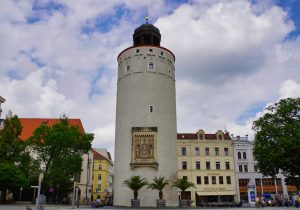Görlitz not only has a beautiful old town, but also two geographical features to offer. And quite honestly – I wouldn’t have known it!
Why does the sun rise earlier in Görlitz than in other German cities?
Do you know the german saying:
„Im Osten geht die Sonne auf,
im Süden hält sie Mittagslauf,
im Westen will sie untergehn,
im Norden ist sie nie zu sehn.”
“In the east the sun rises,
in the south it holds its noon course,
in the west it wants to set,
in the north it is never to be seen.”
That’s how I learned about the course of the sun when I was at school. And during my visit to Görlitz, I realised – I am in the German city where the sun rises first!

Görlitz is the easternmost city in Germany and this is clearly reflected in the sunrise times:
On 22.6, the longest day of the year, this is quite impressive:
- Germany’s easternmost city Görlitz:
Sunrise: 4:46 a.m., Sunset : 9:18 p.m. - westernmost town in Germany Selfkant:
Sunrise: 5:21 a.m., Sunset: 9:58 p.m.
The difference is quite big, I wouldn’t have thought so.
Why do the clocks in Görlitz always go right?
There was a time when every city had its own time. Depending on when the sun was at its highest point in the city, it was then 12 noon there. The sundial helped to determine the time precisely. As time went by, however, this simple principle became a big problem. For example, if you were travelling from A to B, you had to constantly keep track of the time. Increasing traffic had to be coordinated and timetables had to be drawn up. Difficult when everyone has their own time.

In the first step, the Canadian engineer Sir Sandford Flemming came up with a “railway time”. To this end, he established time zones in 1879. However, this was not yet really satisfactory.

A solution was sought and many meridian conferences later, the earth was divided into 24 time zones. In 1884, the geographical position of the prime meridian, which runs through Greenwich, was determined. Twenty-five nations adopted the Merdian system, which is still valid today. The 360 degrees of longitude that span the world were divided into 24 hours, so there are exactly 15 degrees of longitude per hour.
The then German Empire decided to introduce Central European Standard Time in Germany in the Reich Law Gazette number 7 of 16.3.1893. From 1 April 1893, all clocks were to tick in the same way. And the course of the meridian 15° east of Greenwich was used for this purpose.
If you now look at Görlitz, you will see that the city lies on the 15th meridian. Thus, Görlitz became the timer for 42 countries in Africa and Europe.
So 12 o’clock on the clock in Görlitz also means 12 o’clock local time. Several times a year, depending on the slightly fluctuating sunny days, the time of the sundial is also identical to that of a modern clock.

South of the town hall, almost at the bridge to Poland, a meridian monument was erected in 1961 to show the course of the 15th meridian. The meridian monument looks like a globe, is made of Lusatian granite and is said to weigh 1150 kg. On the sphere is a directional rail that indicates the course of the meridian. If you look along the rail in the direction of the arrow, you are looking exactly north.

But why then does the clock of the Trinity Church always strike too early?
The clothiers’ revolt of 1527 is still responsible today for the church tower clock striking seven minutes early. So that the conspirators, then on their way to their secret meetings, would not run into the arms of the city guard, a traitor had the clock struck earlier.














Leave a Reply